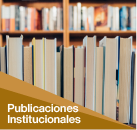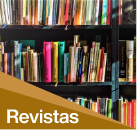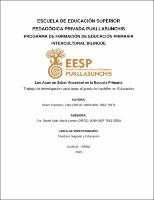Mostrar el registro sencillo del ítem
Los Apus un Saber Ancestral en la Escuela Primaria
| dc.contributor.advisor | Santé Abal, María Loreto | |
| dc.contributor.author | Bravo Carrasco, Lida | es_PE |
| dc.date.accessioned | 2025-06-01T03:20:17Z | |
| dc.date.available | 2025-06-01T03:20:17Z | |
| dc.date.issued | 2023-12-07 | |
| dc.identifier.uri | http://repositorio.pukllasunchis.org/xmlui/handle/PUK/69 | |
| dc.description.abstract | El presente estudio se elabora a partir de una motivación: reflexionar sobre el territorio sagrado, una dimensión que la escuela pública suele considerar muy poco en su propuesta pedagógica. Con este trabajo quiero valorar las concepciones o maneras de ver el espacio geográfico tanto desde la visión más tradicional de las instituciones educativas en nuestro país como desde la visión de los pueblos originarios y especialmente andinos, y cómo su visión de territorio sagrado podría influir en la propuesta pedagógica de las Instituciones educativas Educación Intercultural Bilingüe (EIB). Este tema me llama la atención por la forma diferente de ver el territorio que tienen estos pueblos y mi propia cultura andina. Me interesa recalcar la importancia de los conocimientos y saberes que tienen las personas sobre cada territorio cultural y de este modo, poder preservar el sentido de pertenencia e identidad cultural en los niños y niñas y con ello lograr un aprendizaje significativo y relevante en las instituciones educativas. Para lograr mi objetivo realicé una revisión sobre la situación de la EIB en el Perú, la incorporación de los saberes ancestrales a la EIB y la importancia de la concepción del territorio sagrado para el desarrollo de este tipo de educación. Finalmente, me centré en una entidad muy importante del territorio sagrado andino, los Apus (cerros sagrados), como un saber ancestral que es importante incorporar a la educación intercultural. Considero que este trabajo puede ayudar a otros docentes a tener una apertura distinta de conocer y percibir el territorio como una forma muy significativa de acercarse a la cultura andina. | es_PE |
| dc.description.abstract | Abstract The following study is developed from a motivation: to reflect on sacred territory, a dimension that public schools often pay little attention to in its pedagogical proposal. With this work, I aim to value the conceptions or ways of viewing geographical space both from the traditional perspective of educational institutions in our country and from the viewpoint of indigenous peoples, especially the Andean communities, and how considering their view of the sacred territory might influence the pedagogical proposal of Bilingual Intercultural Education Institutions (EIB). This topic catches my attention due to the distinct way these communities view territory, as well as my own Andean culture. I am keen on emphasizing the importance of the knowledge and wisdom individuals have about each cultural territory and, in this way, to preserve the sense of belonging and cultural identity in boys and girls, achieving meaningful and relevant learning at schools. To achieve my objective, I conducted a review of the situation of EIB in Peru, the incorporation of ancestral knowledge into EIB, and the significance of the concept of sacred territory for the development of this type of education. Lastly, I focused on a vital entity of the Andean sacred territory, the Apus (sacred hills), as ancestral knowledge that is crucial to incorporate into intercultural education. I believe this work can assist other educators in gaining a different openness to recognizing and perceiving territory as a profoundly meaningful way of connecting with Andean culture. Keywords: Intercultural Bilingual Education, EIB, Andean culture, ancestral knowledge, Apus, sacred hills, sacred territory. | es_PE |
| dc.description.abstract | Pisiy rimayllapi willasayki Kay yachayqa huk kallpanchakuymantam paqarimunchkan: allpa suyu nisqamanta yuyaymananaypaq, huk qawariymanta qallarispa, chaytam llapan yachaywasikunapi ancha pisillata qawarinku, mana ancha yuyaymankuchu. Kay llamkaywanmi chaninchayta munani hamutaykunata utaq imayana qawaykunata kay allpa suyu nisqamanta ichaqa chaninchaspa, aswantaqa Educación Intercultural Bilingüe (EIB) nisqa yachaywasikunapi ñawpaqmantaraq qawariymanta, ahinataq qawa llaqtakunapipas. Kay yachayqa yuyayniytan hap’iwan, chay allpa suyu huknirayta qhawarisqankurayku. anchata qallariyta munani imaynatan sapanka ayllukuna qawarinku kay pacha mamata, allpa suyuta ima. yachayninkunamanta, kawsayninkunamanta qawarispa chay yachaykunata irqichakunaman yachachispa, anchata chay suyunkuta munakunankupaq hinallataq chay yachaykunata kallpachaspa yachachinaypaq. imaraykuchus kay k’uskipayqa ruwakun allin yuyaychasqa estrategias nisqakunata maskaspa kay (EIB) nisqamanta willakuykunata maskaymanta, imakunam ñawpaq yachaykunapi wiñasqa kasqanmanta, chaynallataq imakunam chay allpa suyupi ima, aswan allintaqa Apukunamantawan (huaca urqu), ñawpaq yachaykunata, willakuykunata yachachinapaq. ñuqa yuyaychani kay llamkayta huk yachachiqkunata, hamautakunata yanapanman hukniray kichariyniyuq kanankupaq, chaynapi kay allpa suyuta riqsinankupaq hinaspa qawanankupaq, chaynapi cultura andina nisqaman achuykunankupaq. Chanin rimaykuna: EIB nisqa,qawa kawsay, quipa yachaykuna nisqa, apukuna, yupaychana allpa, nisqa, yupaychana urqukuna. | es_PE |
| dc.format | application/pdf | es_PE |
| dc.language.iso | spa | es_PE |
| dc.publisher | Asociación Pukllasunchis | es_PE |
| dc.rights | info:eu-repo/semantics/openAccess | es_PE |
| dc.rights.uri | https://creativecommons.org/licenses/by-nc-sa/4.0/ | es_PE |
| dc.subject | Educación Intercultural Bilingüe | es_PE |
| dc.subject | Saberes Ancestrales | es_PE |
| dc.subject | cultura andina | es_PE |
| dc.title | Los Apus un Saber Ancestral en la Escuela Primaria | es_PE |
| dc.type | info:eu-repo/semantics/bachelorThesis | es_PE |
| dc.type.version | info:eu-repo/semantics/publishedVersion | es_PE |
| dc.publisher.country | PE | es_PE |
| dc.subject.ocde | https://purl.org/pe-repo/ocde/ford#5.03.01 | es_PE |
| renati.advisor.orcid | https://orcid.org/0009-0007-7582-2550 | es_PE |
| renati.type | https://purl.org/pe-repo/renati/type#trabajoDeInvestigacion | es_PE |
| renati.level | https://purl.org/pe-repo/renati/nivel#bachiller | es_PE |
| renati.discipline | 112096 | es_PE |
| renati.juror | Eguiluz Duffy, Cecilia María | es_PE |
| renati.juror | Guevara Zambrano, Carlos Andrés | es_PE |
| renati.juror | Santisteban Matto, Ruth Dina | es_PE |
| renati.juror | Sullca Tito, Hernan | es_PE |
| thesis.degree.name | Bachiller en Educación Primaria Intercultural Bilingüe | es_PE |
| thesis.degree.discipline | Educación Primaria Intercultural Bilingüe | es_PE |
| thesis.degree.grantor | Escuela de Educación Superior Pedagógica Privada Pukllasunchis | es_PE |
| renati.author.dni | 77052830 | |
| renati.advisor.cext | 000201343 |







